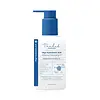What's inside
What's inside
 Key Ingredients
Key Ingredients

 Benefits
Benefits

 Concerns
Concerns

No concerns
 Ingredients Side-by-side
Ingredients Side-by-side

Water
Skin ConditioningDipropylene Glycol
HumectantGlycerin
HumectantButylene Glycol
HumectantDecyl Glucoside
CleansingCoco-Glucoside
Cleansing1,2-Hexanediol
Skin ConditioningAcrylates/C10-30 Alkyl Acrylate Crosspolymer
Emulsion StabilisingHydroxyacetophenone
AntioxidantTromethamine
BufferingXanthan Gum
EmulsifyingGlyceryl Acrylate/Acrylic Acid Copolymer
HumectantDisodium EDTA
Hydrolyzed Hyaluronic Acid
HumectantPolyquaternium-51
Skin ConditioningSimmondsia Chinensis Seed Oil
EmollientWater, Dipropylene Glycol, Glycerin, Butylene Glycol, Decyl Glucoside, Coco-Glucoside, 1,2-Hexanediol, Acrylates/C10-30 Alkyl Acrylate Crosspolymer, Hydroxyacetophenone, Tromethamine, Xanthan Gum, Glyceryl Acrylate/Acrylic Acid Copolymer, Disodium EDTA, Hydrolyzed Hyaluronic Acid, Polyquaternium-51, Simmondsia Chinensis Seed Oil
Water
Skin ConditioningGlycerin
HumectantCetyl Ethylhexanoate
EmollientHelianthus Annuus Seed Oil
EmollientButylene Glycol
HumectantSorbitan Olivate
EmulsifyingGlyceryl Stearate Se
EmulsifyingCeramide NP
Skin ConditioningCeramide AP
Skin ConditioningCholesterol
EmollientStearic Acid
CleansingPanthenol
Skin ConditioningSodium Hyaluronate
HumectantGlycine Soja Seed Extract
Skin ConditioningLactobacillus/Soymilk Ferment Filtrate
Skin ConditioningCentella Asiatica Extract
CleansingFicus Carica Fruit Extract
HumectantHydrogenated Lecithin
EmulsifyingC14-22 Alcohols
Emulsion Stabilising1,2-Hexanediol
Skin ConditioningDecyl Glucoside
CleansingHydroxyacetophenone
AntioxidantArginine
MaskingCarbomer
Emulsion StabilisingC12-20 Alkyl Glucoside
EmulsifyingEthylhexylglycerin
Skin ConditioningBehenyl Alcohol
EmollientSimmondsia Chinensis Seed Oil
EmollientTocopherol
AntioxidantSodium Phytate
Coptis Japonica Root Extract
Skin ConditioningMalt Extract
Skin ProtectingCaprylic/Capric Triglyceride
MaskingGlyceryl Stearate
EmollientCetearyl Alcohol
EmollientTetraacetylphytosphingosine
Skin ConditioningGlycosphingolipids
EmollientXanthan Gum
EmulsifyingWater, Glycerin, Cetyl Ethylhexanoate, Helianthus Annuus Seed Oil, Butylene Glycol, Sorbitan Olivate, Glyceryl Stearate Se, Ceramide NP, Ceramide AP, Cholesterol, Stearic Acid, Panthenol, Sodium Hyaluronate, Glycine Soja Seed Extract, Lactobacillus/Soymilk Ferment Filtrate, Centella Asiatica Extract, Ficus Carica Fruit Extract, Hydrogenated Lecithin, C14-22 Alcohols, 1,2-Hexanediol, Decyl Glucoside, Hydroxyacetophenone, Arginine, Carbomer, C12-20 Alkyl Glucoside, Ethylhexylglycerin, Behenyl Alcohol, Simmondsia Chinensis Seed Oil, Tocopherol, Sodium Phytate, Coptis Japonica Root Extract, Malt Extract, Caprylic/Capric Triglyceride, Glyceryl Stearate, Cetearyl Alcohol, Tetraacetylphytosphingosine, Glycosphingolipids, Xanthan Gum
 Reviews
Reviews

Ingredients Explained
These ingredients are found in both products.
Ingredients higher up in an ingredient list are typically present in a larger amount.
1,2-Hexanediol is a synthetic liquid and another multi-functional powerhouse.
It is a:
- Humectant, drawing moisture into the skin
- Emollient, helping to soften skin
- Solvent, dispersing and stabilizing formulas
- Preservative booster, enhancing the antimicrobial activity of other preservatives
Butylene Glycol (or BG) is used within cosmetic products for a few different reasons:
Overall, Butylene Glycol is a safe and well-rounded ingredient that works well with other ingredients.
Though this ingredient works well with most skin types, some people with sensitive skin may experience a reaction such as allergic rashes, closed comedones, or itchiness.
Learn more about Butylene GlycolDecyl Glucoside is a glucose-based surfactant and emulsion stabilizer. It is created by reacting glucose with the fatty acids from plants.
Surfactants help clean the skin by trapping oil, sebum, and dirt to be washed away. As an emulsion stabilizer, it stabilizes the ingredients in a product by preventing them from separating.
This ingredient is biodegradable and non-toxic. This ingredient is commonly found in baby shampoos.
Decyl Glucoside is sometimes used to stabilize the UV filter Tinosorb.
Learn more about Decyl GlucosideGlycerin is already naturally found in your skin. It helps moisturize and protect your skin.
A study from 2016 found glycerin to be more effective as a humectant than AHAs and hyaluronic acid.
As a humectant, it helps the skin stay hydrated by pulling moisture to your skin. The low molecular weight of glycerin allows it to pull moisture into the deeper layers of your skin.
Hydrated skin improves your skin barrier; Your skin barrier helps protect against irritants and bacteria.
Glycerin has also been found to have antimicrobial and antiviral properties. Due to these properties, glycerin is often used in wound and burn treatments.
In cosmetics, glycerin is usually derived from plants such as soybean or palm. However, it can also be sourced from animals, such as tallow or animal fat.
This ingredient is organic, colorless, odorless, and non-toxic.
Glycerin is the name for this ingredient in American English. British English uses Glycerol/Glycerine.
Learn more about GlycerinHydroxyacetophenone is antioxidant with skin conditioning and soothing properties. It also boosts the efficiency of preservatives.
This ingredient is not irritating or sensitizing.
This oil comes from the seeds of the desert shrub called Jojoba. It is more commonly known as jojoba oil, a non-comedogenic oil.
Jojoba oil does not contain fragrance and has many fatty-acids, making it a great soothing ingredient.
It also contains Vitamin E, a great moisturizing ingredient. Vitamin E is also an antioxidant and protects your skin against oxidative damage.
This ingredient humectant properties, meaning it helps draw moisture from the air. This helps keep your skin hydrated.
While jojoba has antibacterial properties, it is only able to kill some strains of bacteria.
Studies also show it helps in wound healing. In fact, Indigenous cultures have used jojoba as a moisturizer and to help treat burns for centuries.
Fun fact: Jojoba oil similar to natural human skin sebum, so it has a great effect on dry skin. It is also promising with helping to regulate sebum production.
Due to its fatty acid content, Jojoba oil may not be fungal acne safe. We recommend speaking with a professional if you have any concerns.
Learn more about Simmondsia Chinensis Seed OilWater. It's the most common cosmetic ingredient of all. You'll usually see it at the top of ingredient lists, meaning that it makes up the largest part of the product.
So why is it so popular? Water most often acts as a solvent - this means that it helps dissolve other ingredients into the formulation.
You'll also recognize water as that liquid we all need to stay alive. If you see this, drink a glass of water. Stay hydrated!
Learn more about WaterXanthan gum is used as a stabilizer and thickener within cosmetic products. It helps give products a sticky, thick feeling - preventing them from being too runny.
On the technical side of things, xanthan gum is a polysaccharide - a combination consisting of multiple sugar molecules bonded together.
Xanthan gum is a pretty common and great ingredient. It is a natural, non-toxic, non-irritating ingredient that is also commonly used in food products.
Learn more about Xanthan Gum